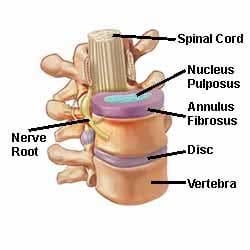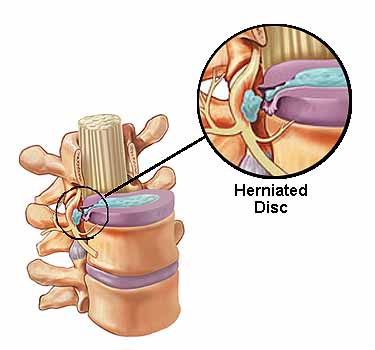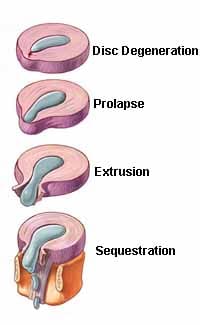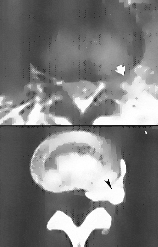Herniation of the nucleus pulposus, abbreviated as HNP, occurs when the nucleus pulposus, frequently described to have a gel-like substance, breaks through the anulus fibrosus, the tire-like structure of the intervertebral disc which acts as a spinal shock absorber.
A herniated disc occurs most frequently in the lumbar region of the backbone or spine, particularly at the L4-L5 and L5-S1 levels (L = Lumbar and S = Sacral). This is primarily because the lumbar spine generally carries the majority of the body’s weight. Since the elasticity and water content of the nucleus decreases with age through the natural process of degeneration, individuals between the ages of 30 and 50 often seem to be more vulnerable to disc herniation.


The progression of a herniation of the nucleus pulposus, best known as a herniated disc, can vary and typically occurs gradually over time. There are four stages: (1) disc protrusion (2) prolapsed disk (3) disc extrusion (4) sequestered disc. Stages 1 and 2 are known as incomplete disc herniations, or as a disc bulge, where 3 and 4 are known as complete disc herniations, ruptured discs or herniated discs. Pain may be combined with some radiculopathy, which means deficit. The deficit might include sensory alterations, such as tingling sensations and/or numbness, or motor changes, such as weakness and/or weight loss. Nerve compression resulting from added pressure, compression or impingement of the spinal nerves due to the substance from the herniated disc is often what causes these changes.

Progression of Herniated Disc
The extremities affected by herniated discs are dependent upon the vertebral level at which they occur in. Consider the following examples:
- Cervical – Pain, discomfort and other symptoms in the throat, shoulders, and arms.
- Thoracic – Symptoms radiate into the chest.
- Lumbar – Symptoms extend into the buttocks, thighs, legs and feet. Sciatica is common.
Cauda Equina Syndrome is serious disorder requiring immediate surgical intervention which occurs from from a disc herniation. The symptoms include bilateral leg pain, reduction of perianal sensation (rectum), paralysis of the bladder, and weakness of the anal sphincter.
Analysis of Herniated Discs
The backbone is analyzed with the patient standing and laying down. Because of muscle spasm, a loss of normal spinal curvature may be noted. Radicular pain, described as inflammation of a spinal nerve, may increase if pressure is placed on the affected spinal segment.
A Lasegue test, also known as Straight-leg Raising Test, is often performed to determine the extent of the herniated disc and its manifested symptoms. To perform this test, the patient lies down, the knee is extended, and the hip is flexed. If pain is aggravated or produced, it is an indication the lower lumbosacral nerve roots may be inflamed.
Other neurological tests are performed to ascertain loss of sensation and/or engine function. Reflexes are noted as these changes may indicate the location of the herniation.
Radiographs can be helpful to determine the presence of a herniated disc, but Computed Axial Tomography (CAT) or Magnetic Resonance Imaging (MRI) provides more detail. The MRI is the best method allowing the physician to find the soft spinal tissues that are unseen in other imaging procedures.
Evidence of HNP
The findings in the examination and evaluations, such as the one below, are compared to earn a diagnosis. This includes ascertaining the precise location of the herniation so treatment options can be reviewed with the patient.


The scope of our information is limited to chiropractic and spinal injuries and conditions. To discuss options on the subject matter, please feel free to ask Dr. Jimenez or contact us at 915-850-0900 .
By Dr. Alex Jimenez
Additional Topics: Sciatica
Lower back pain is one of the most commonly reported symptoms among the general population. Sciatica, is well-known group of symptoms, including lower back pain, numbness and tingling sensations, which often describe the source of an individual’s lumbar spine issues. Sciatica can be due to a variety of injuries and/or conditions, such as spinal misalignment, or subluxation, disc herniation and even spinal degeneration.





